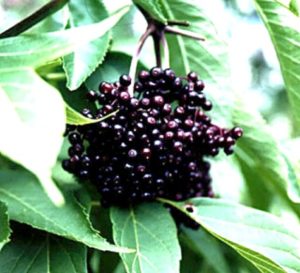The Elder Tree
By: Joel “Wind Fox” Boyle, Herbalist
With pleasant shade and subtle grace, the Elder tree has
captivated the mind, body, and soul since its first involvement w ith mankind. A
ith mankind. A
deciduous tree that can grow up to thirty-five feet in height, it bears oval toothed
leaflets that are pinnately divided and opposite. Having white to whitish flowers
that emerge in mid-summer later falling off to make way for juicy clusters of berries
(normally black, blue, or purple) in autumn. Elder is a wonderful friend that has
incorporated itself into every aspect of human existence the appearance of the berries
being a signal for the beginning of wheat sowing; the berries themselves being used
as a nutritious tonic for the mind, body, and spirit; Elders use as a black dye
for hair and fabric; the entire plant is used in various ways medicinally; and many
other uses to numerous to list here. In herbalism usually only the ripe berries
and flowers are used internally, this is due to the presence of cyanogenic glucosides,
hydrocyanic acid, and Sambuline (all of which are toxic) concentrated in the rest
of the plant.
 From jams to jellies to syrups to juice as well as a diverse
From jams to jellies to syrups to juice as well as a diverse
array of dishes, the berries from the Elder tree are a delicious, nutritious treat
for all peoples young or old. Diaphoretic, diuretic, aperient, and high in vitamin
C, their benefit goes well beyond this simple summarization. It is one of the most
effective natural remedies for preventing and treating upper respiratory infections,
constipation, and fever; as well as stimulating the immune system. Elder berries
contain substances called sambucus nigra agglutinins (SNAs) that can lock onto receptor
sites on certain strains of flu viruses thereby keeping them from infecting human
cells. Other flu strains use enzyme spikes that dissolve the walls of healthy cells,
allowing entrance to the virus and furthering infection. However, compounds in Elder
berries thwart this process, offering protection against at least eight strains
of the human influenza virus (flu shots only immunize against three strains at most).
Therefore extracts could offer significant added protection as well as reducing
the duration of infection in affected individuals. Elder berries have also been
shown to assist in relieving nasal congestion and sore throat; they have also shown
some activity in preliminary trials against viruses such as herpes simplex and human
immunodeficiency virus (HIV). As with most of our powerful plant healers, care should
be taken with its use. Uncooked berries can cause nausea and vomiting; and large
doses of Elderberry juice can cause loose stools to severe diarrhea.
Almost a pharmacy in itself, the berries (though delicious
indeed) are not the only star of this wonderful ally. The flowers are also widely
acclaimed for their wealth of benefits. Traditionally used for colds, fevers, and
clearing the skin; Elder flowers are diaphoretic, alterative, detoxicant, and anti-inflammatory.
When prepared as a flower infusion, the properties can be somewhat altered the cold
infusion is diuretic, alterative, and cooling; while the  warm infusion is diaphoretic
warm infusion is diaphoretic
and gently stimulating. Elder flowers also work well in combination with other herbs,
with mint and yarrow for internal detoxification of colds and flu; or with sassafras
(externally) for clearing the skin of blemishes such as acne. Salve, oil, or ointment
made from the flowers is excellent for burns, cuts, scratches, abrasions, chapped
hands, chilblains, and various skin diseases. And as if all these great benefits
from the flowers are not enough, the leaves are used externally for their vulnerary
and emollient properties especially to assist in the relief of bruises, hemorrhoids,
inflammations, sprains, and wounds. The seeds also have a history of use for dropsy
(for which they are powdered).
Normally growing abundantly in the wild, most do not usually
think to propagate it which can be done easily from the suckers (which, to put it
mildly, are produced quite freely). They do best in moist, fertile soil with full
sun to partial shade but theyll also forgive a lot of shortcomings in their location
and care (in fact their vigor can be a problem). Best suited to a wild garden, Elder
will not co-habitate well in gardens with lots of little treasures nearby. Care
should be taken in its removal however, according to folk tradition in Denmark which
believes that the Elder-tree mother-spirit resides within in the tree. It is said
that she would haunt anyone who cuts one down, which of course could be negated
with a proper offering and show of respect. So, just like everything in life, the
more you put in it (love, respect, kindness, knowledge, etc) the more you will truly
get out of it. Definitely a plant spirit medicine we can all work with and learn
a great deal from. Good luck, good health, and may we all work towards healing the
planet and ourselves.
Resources / Bibliography
- Balch, Phyllis A., CNC. Prescription for Herbal
Healing, Avery (a member of Penguin Putnam Inc.), New York, NY, 2002. - Green, James, Herbalist. The Herbal Medicine-Makers
Handbook, The Crossing Press, Berkeley, CA, 2000. - Hylton, William H. and Kowalchik, Claire (editors).
Rodales Illustrated Encyclopedia of Herbs, Rodale Press, Inc., Emmaus, PA,
1998. - Santillo, Humbart, N.D. Natural Healing with Herbs,
Hohm Press, Prescott, AZ, 1993 (10th printing). - Tierra, Michael, N.D. Planetary Herbology,
Lotus Press, Twin Lakes, WI, 1992.